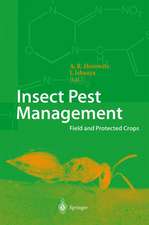Bioeconomy for Beginners
Editat de Joachim Pietzsch Ilustrat de Stephan Meyer Desene de Wolfgang Zettlmeier Ulrich Schurren Limba Engleză Hardback – 7 mar 2020
This book conceives the realization of bioeconomy as a threefold task – a scientific, an economic and an ecological one.
· Where does the biomass come from that we need primarily for feeding the growing world population but also for future energy and material use? How can it be processed in biorefineries and what role does biotechnology play in this regard?
· Which aspects of innovation economics need to be considered, which economic aspects of value creation, competitiveness and customer acceptance are important? · What conditions must a bioeconomy fulfil in order to enable a sustainable development of life on earth? May it be regarded as a key to further economic growth or shouldn’t it rather orient itself towards the ideal of sufficiency?
By dealing with these questions from the not necessarily consistent perspectives of proven experts, this book provides an interdisciplinary overview of a dynamic field of research and practice that raises more questions than answers and thus may nurture the motivation of many more people to seriously engage for the realization of a bioeconomy.
Preț: 597.15 lei
Preț vechi: 775.51 lei
-23% Nou
Puncte Express: 896
Preț estimativ în valută:
114.27€ • 120.16$ • 94.42£
114.27€ • 120.16$ • 94.42£
Carte tipărită la comandă
Livrare economică 14-19 aprilie
Preluare comenzi: 021 569.72.76
Specificații
ISBN-13: 9783662603895
ISBN-10: 3662603896
Pagini: 339
Ilustrații: XIII, 214 p. 170 illus., 168 illus. in color.
Dimensiuni: 210 x 279 x 18 mm
Greutate: 0.77 kg
Ediția:1st ed. 2020
Editura: Springer Berlin, Heidelberg
Colecția Springer
Locul publicării:Berlin, Heidelberg, Germany
ISBN-10: 3662603896
Pagini: 339
Ilustrații: XIII, 214 p. 170 illus., 168 illus. in color.
Dimensiuni: 210 x 279 x 18 mm
Greutate: 0.77 kg
Ediția:1st ed. 2020
Editura: Springer Berlin, Heidelberg
Colecția Springer
Locul publicării:Berlin, Heidelberg, Germany
Cuprins
Chapter 1: Introduction.- Chapter 2: The origin of biomass.- Chapter 3: Food security and healthy nutrition in the context of the bioeconomy.- Chapter 4: The use of biomass for the production of fuel and chemicals.- Chapter 5: The importance of biotechnology for bioeconomy.- Chapter 6: The bioeconomy from the point of view of the innovation economy.- Chapter 7: Bioeconomy as a circular and integrated system.- Chapter 8: Criteria for the success of the bioeconomy.- Chapter 9: The conditions of a sustainable bioeconomy.- Chapter 10: Bioeconomy – Key to unlimited economic and consumer growth?.
Notă biografică
Joachim Pietzsch is an independent science writer and senior communications consultant based in Frankfurt/Main, Germany.
Textul de pe ultima copertă
This book provides an interdisciplinary and comprehensible introduction to bioeconomy. It thus offers basic knowledge for understanding a transformation process that will shape the 21st century and requires the integration of many, so far unrelated disciplines and industries. We are talking about the gradual and necessary transition from the age of fossil fuels, which began around 200 years ago, to a global economy based on renewable raw materials (and renewable energies). The success of this transition is key to coping with the challenge of climate change.
This book conceives the realization of bioeconomy as a threefold task – a scientific, an economic and an ecological one.
· Where does the biomass come from that we need primarily for feeding the growing world population but also for future energy and material use? How can it be processed in biorefineries and what role does biotechnology play in this regard?
· Which aspects of innovation economics need to be considered, which economic aspects of value creation, competitiveness and customer acceptance are important?
· What conditions must a bioeconomy fulfil in order to enable a sustainable development of life on earth? May it be regarded as a key to further economic growth or shouldn’t it rather orient itself towards the ideal of sufficiency?
By dealing with these questions from the not necessarily consistent perspectives of proven experts, this book provides an interdisciplinary overview of a dynamic field of research and practice that raises more questions than answers and thus may nurture the motivation of many more people to seriously engage for the realization of a bioeconomy.
This book conceives the realization of bioeconomy as a threefold task – a scientific, an economic and an ecological one.
· Where does the biomass come from that we need primarily for feeding the growing world population but also for future energy and material use? How can it be processed in biorefineries and what role does biotechnology play in this regard?
· Which aspects of innovation economics need to be considered, which economic aspects of value creation, competitiveness and customer acceptance are important?
· What conditions must a bioeconomy fulfil in order to enable a sustainable development of life on earth? May it be regarded as a key to further economic growth or shouldn’t it rather orient itself towards the ideal of sufficiency?
By dealing with these questions from the not necessarily consistent perspectives of proven experts, this book provides an interdisciplinary overview of a dynamic field of research and practice that raises more questions than answers and thus may nurture the motivation of many more people to seriously engage for the realization of a bioeconomy.
Caracteristici
Bioeconomy presented as a promising subject for the future Understandably explains the scientific, economic and ecological facets of the project Renowned contributors



![Agricultural Impacts of Climate Change [Volume 1]](https://i3.books-express.ro/bt/9780367345235/agricultural-impacts-of-climate-change-volume-1.jpg)

























